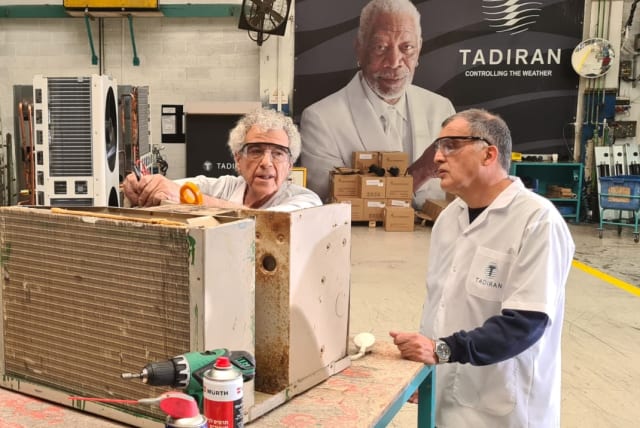Air conditioning system in PM Ben-Gurion's Sde Boker home restored

Teams of retired technicians came back for a special project: restoring a long-retired air conditioning unit in the former home of Israel's first Prime Minister, David Ben-Gurion.
The State of Israel is approaching a massive milestone - 75 years! Leading up to Independence Day and the 50th anniversary of David Ben-Gurion's passing, the institute in his name is celebrating by restoring the air-conditioner in his home in Sde Boker. This initiative is the result of Tadiran's commitment to improving air quality for all visiting this historic Negev landmark.
Months ago, the Ben-Gurion Institute decided to restore the small former home of Israel's first prime minister in Sde Boker, a kibbutz in the epicenter of the Negev desert in southern Israel. There's something even more special and symbolic about this move, though: this was one of Israel's very first-ever-made air conditioning units!
The old air-conditioner, practically antique at this point, was used by the Prime Minister and his wife, Paula Ben-Gurion in the sweltering Negev summer heat. The unit itself was the WLBILT model, which has since been phased out for nearly 60 years.Now, the former PM's home now acts as a museum that draws more than 100,000 visitors annually.
The home is kept in the same state since the passing of David Ben Gurion in December 1973, at 87 years old.
How can an air-conditioning unit be this old and still work?
Though discontinued in the 1960's, the air-conditioners in this small Negev dwelling managed to stay alive and well through the late 1990s, allowing the many visitors to stay cool during the hot summer months.
The unit's original manufacturer, Tadiran, is now working to preserve it in a company factory in Afula. The company had brought back retired employees to take on a special task. All who have returned are not back for good, Tadiran said in a statement, noting specifically that they have come back to help with a one-off project that requires knowledge from the old days.
In 1959, Denver-based philanthropist Hannah Logasa donated funds for air-conditioning to the Midreshet Ben-Gurion educational center.
"The weather in the Negev might, perhaps, justify use of air-conditioners," Ben-Gurion said at the time. "Although I wonder if it would be wise to let our people become dependent on an ultra-modern accessory like this. In fact, I am of the opinion that it would be better to adapt ourselves to the weather conditions prevailing in this part of the world, rather than the other way around,” he wrote in his book.
However, he agreed to install the air-conditioner in his small, yet cozy home, but only after he stepped down from his post as head of state in 1963 and went on to spend the rest of his days in his home in Sde Boker.
"As the items in the small house have become older over the years, it is important for us to ensure their preservation so that in the future visitors will also be able to get the impression and experience how and where the State of Israel's first prime minister lived," Gil Schneider, Manager of the Ben-Gurion Home Heritage Site said.
"The air-conditioner that was used by Ben-Gurion has already been significantly worn down and requires delicate and complicated restoration work. We were very happy that Tadiran has risen to the task and taken on the air-conditioner as a flagship project of the company."
Along with the restored mazgan - the Hebrew word for air-conditioning - new air purifiers have also been added to the space.
Why is Sde Boker an important place to visit?
Kibbutz Sde Boker is historically significant to show just how far the state of Israel has come since its earliest days. Founded in 1952 by pioneering families who wanted to find hospitable locations and conditions within the Negev Desert, this location has had a massive impact on the future of life in Israel's southern region.
Shortly after a visit to Mitzpe Ramon, just south of Sde Boker, Prime Minister Ben-Gurion saw a grouping of tents and simple buildings along a roadside before asking his driver who inhabited the area. He was told that pioneering families had relocated from the center in order to establish a desert settlement. After that moment, David Ben-Gurion's vision for the nation became clearer than ever.
Israeli tour provider Tourist Israel's website said that when Ben-Gurion returned to his home in Tel Aviv, which was at the time the newly-birthed nation's capital, he reached out to members of the kibbutz, telling them that he has never “envied a person, nor the qualities of anyone or their property. But when I visited Sde Boker I was unable to stop being jealous and envious of you: Why wouldn’t I deserve to participate in a community like this?”
So, after kibbutz members turned to a vote, they ultimately decided that the Prime Minister would be helpful to the cause and further development of their community, allowing the elderly head of state to make Sde Boker his home.
Today, Sde Boker has relocated a few hundred feet from the original community of huts and is part of the Ramat HaNegev Regional Council (a group of rural settlements in this region of the Negev). The main industries of the kibbutz are its vineyard and winery, as well as various tourism businesses, and agricultural industries.
Ben-Gurion hosted many world leaders at his Sde Boker home. Without his passion for the place, the Negev region would have likely never flourished in the way it did. Now, thanks to his efforts to secure investment in infrastructure, communities in the region can thrive.
Jerusalem Post Store
`; document.getElementById("linkPremium").innerHTML = cont; var divWithLink = document.getElementById("premium-link"); if (divWithLink !== null && divWithLink !== 'undefined') { divWithLink.style.border = "solid 1px #cb0f3e"; divWithLink.style.textAlign = "center"; divWithLink.style.marginBottom = "15px"; divWithLink.style.marginTop = "15px"; divWithLink.style.width = "100%"; divWithLink.style.backgroundColor = "#122952"; divWithLink.style.color = "#ffffff"; divWithLink.style.lineHeight = "1.5"; } } (function (v, i) { });

